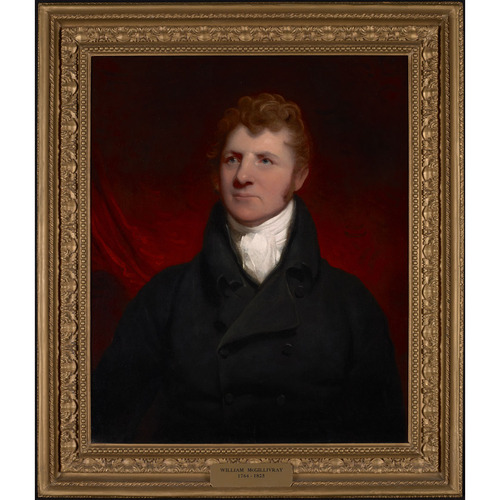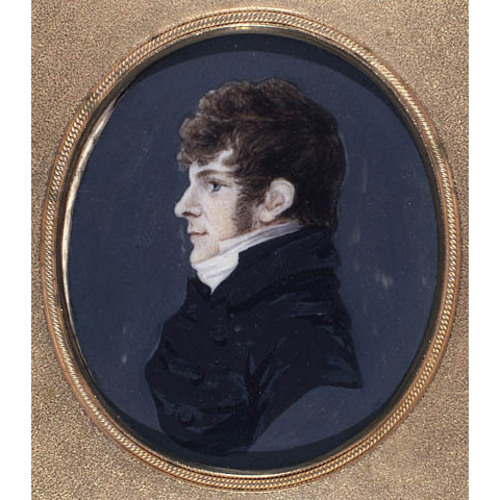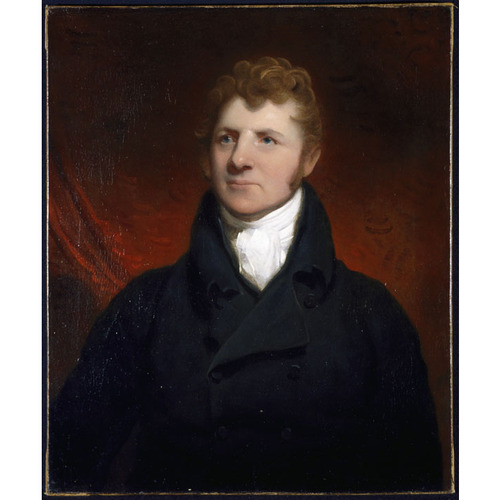McGILLIVRAY, WILLIAM, fur trader, landowner, jp, office holder, politician, and militia officer; b. 1764 in Dunlichty, Scotland, son of Donald McGillivray and Anne McTavish, Simon McTavish*’s sister; m. first c. 1790 a mixed-blood woman named Susan à la façon du pays, and they had three sons and a daughter; m. secondly 22 Dec. 1800 Magdalen McDonald in London, and they had six children of whom four died in infancy; d. there 16 Oct. 1825.
William McGillivray came from a poor family unable to meet the costs of educating all six children. By unexpected good luck, his uncle Simon McTavish, who had been living in North America for 12 years, came to visit the family in 1776 and began a tradition by promising to finance secondary education for William and his brother Duncan*. For McTavish it was an investment, since in 1784 he brought William to Montreal and hired him to work for the North West Company at an annual salary of £100. At 20 William thus began the long and hard period of apprenticeship in the fur-trading business. The following year he was posted to the Red River department as a clerk, and in 1786, accompanied by proprietor Patrick Small, he reached the post at Île-à-la-Crosse (Sask.).
McGillivray spent the winter of 1786–87 at Snake Lake, where he had been given the task of setting up a trading post to compete with Gregory, MacLeod and Company [see John Gregory*; Normand MacLeod*]. He and Roderick McKenzie* served their respective companies by living without conflict and on good terms with each other. When they learned about the murder of John Ross, a member in Gregory, MacLeod and Company and formerly a partner in the NWC, the two men hastily went to Grand Portage (near Grand Portage, Minn.). There they apparently played a role in the merger of the two companies in 1787, which was to McTavish’s advantage.
There were some remarkable men in the NWC, among them Peter Pond* and Alexander Mackenzie*, both of whom felt the lure of the unexplored far west. Pond retired in 1788 after a chequered career; the following year Mackenzie travelled down the river that bears his name to the Arctic Ocean. Meanwhile McGillivray had returned to Île-à-la-Crosse, and in September 1789 he was trading at Rat River (Man.). The following year, on buying Pond’s share for £800, he became a partner of the NWC and was promoted to the rank of proprietor with responsibility for the English (Churchill) River department. His headquarters were at Île-à-la-Crosse, where 80 men and about 40 Indian and Métis women lived. In 1791 he was given charge of the westernmost department, Athabasca, which would be extended to the Pacific by Mackenzie in 1793.
McGillivray was engaged in an experience that would eventually lead him to head the NWC, which was increasingly dominated by McTavish. On his return to Montreal in 1793, and before leaving for England and Scotland, he was made a partner in McTavish, Frobisher and Company [see Joseph Frobisher*], which managed the NWC and which at this time controlled the affairs of the larger firm. Specifically, with John Gregory he was to supervise the huge depot at Grand Portage. This promotion stirred the jealousy of the other partners, and certain proprietors spoke of nepotism. But these reactions did not impede McGillivray’s advancement: when Alexander Mackenzie joined McTavish, Frobisher and Company in 1795, he simply became McGillivray’s assistant at Grand Portage. After 1796 McGillivray continued to rise in the upper echelons of the company’s management, and when Frobisher retired in 1798 McGillivray took his place. He was; it seems, involved in all the important matters: the establishment of an agency in New York; the activities of McTavish, Fraser and Company in London, a firm founded by McTavish in 1788 and managed by his cousin John Fraser; trade with China; the move from Grand Portage to Kaministiquia (Thunder Bay, Ont.) in 1803; relations with the Hudson’s Bay Company; and the struggle with the New North West Company (sometimes called the XY Company) [see John Richardson].
When McTavish died in July 1804, McGillivray became both executor of his uncle’s will and his successor as head of the NWC. He took over at a period of intense competition in the fur sector. His immediate responsibility was to draw up the terms of an agreement putting an end to five years of rivalry with the XY Company which would serve as the basis for a coalition between the two groups. By the contract of 5 Nov. 1804 the NWC gave up 25 per cent of its shares to the XY Company. But despite being McGillivray’s close friend, Alexander Mackenzie, who had bought into the New North West Company in 1800, was excluded from the new co-partnership because of his reputation as a trouble-maker in the fur trade.
The reorganization of McTavish, Frobisher and Company was also a delicate task, which McGillivray spread over the next two years. In December 1806, following Gregory’s retirement, which came eight years after Frobisher’s, he announced the new management structure of the firm, to be called McTavish, McGillivrays and Company. William and Duncan McGillivray, their brother-in-law Angus Shaw, and the two Hallowell brothers, James and William, all had places in it. These changes did not affect the status or the role in London of McTavish, Fraser and Company, into which McGillivray brought his younger brother Simon*. Nor were these the only problems to be resolved, since rivalry among the fur companies had been a factor contributing to the rise in salaries, numbers of salaried employees, and costs in general. Besides reducing manpower McGillivray made some decisions that brought into question various costly habits of the proprietors: the way they travelled, kept servants, and maintained their wives and children. Stricter control was imposed on the personal fur-trading of the engagés.
In fact the rise in operating costs and the fall in profits were chiefly linked to the intensified competition with the Americans and the HBC. Although the NWC had dealings with the American John Jacob Astor throughout the period when McGillivray ran the company, the rivalry between him and Astor became increasingly severe. The complexity of their relations was due first to the disruptions in the European market caused by the French revolution. McTavish had established a branch in New York in 1796 to enable the NWC to circumvent the East India Company’s monopoly and send furs to the Chinese market. The NWC first chartered and then bought some ships, which were sailing under the American flag. In this undertaking, but only for a while, it had been necessary to collaborate with Astor, who was involved in the same commercial circuits. There was also cooperation with the Michilimackinac Company [see John Ogilvy*] and Astor’s American Fur Company. But as rivalry with the American capitalist intensified, to retain his freedom of action McGillivray contemplated negotiating with the East India Company and setting up a trading post on the Pacific coast. David Thompson* in his explorations of 1810–11 sought to establish a direct line of communication with the Orient. But by the time Thompson reached the Pacific Ocean in July 1811, Astor’s men, who had come by sea, were already at the mouth of the Columbia River. For a good many years both Canadian and American vessels trading with the Orient, the Isaac Todd, the Racoon, the Colonel Allan, and the Columbia, had profitable runs. In time, however, the losses mounted. All in all, American pressure was applied to the Canadian company in a subtle but systematic fashion.
The rivalry with the HBC would gradually degenerate into a bitter, indeed violent, struggle. Year by year, the territorial expansion of the fur trade had revealed the superiority of the English company with regard to the cost of importing trade goods. McTavish had vainly tried by various means to resolve this problem, which was no closer to solution under McGillivray. The HBC in fact rejected the Nor’Westers’ requests for the right to bring in goods via Hudson Bay. To force the English company’s hand, McTavish had dispatched two expeditions; the one by land gained a foothold on Hayes Island (Ont.) in 1800 and the other by sea landed on Charlton Island (N.W.T.) in 1803. These very costly actions, which by 1806 had entailed the investment of more than £45,000, did not bring the desired results. Neither, it must be added, did the efforts to obtain a charter from the imperial government. There remained one final method, which was used several times, but to no effect: an attempt to purchase a majority of shares in the HBC.
After 1800 the fur trade had been conducted across a territory with quite well-known boundaries. The scarcity of beaver, which had become general, began to be a serious problem about 1810, and according to McGillivray it heightened the rivalry between the two companies. The HBC had already been forced to break with its traditional practice of waiting for the Indians to come to the bay and was seeking to establish posts wherever the Nor’Westers were located [see William Tomison]. This change, along with other circumstances, contributed to increasing costs, particularly that of manpower, which had tripled. The two companies were affected by a drop in profits caused in part by inflation. The NWC was stronger on the ground but it suffered to a greater degree the consequences of external circumstances. The destruction of ils post at Sault Ste Marie, Upper Canada, by the Americans during the War of 1812 [see John Johnston] resulted in a net loss of at least £8,330. In addition, when settlers began arriving in 1812 at the colony established by Lord Selkirk [Douglas*], a shareholder in the HBC, on land granted by the company in 1811 at the junction of the Assiniboine and Red rivers, they met with an unfriendly reception from the NWC. The Nor’Westers considered the settlement a threat to the free transport of goods between their depot at Fort William (Thunder Bay, Ont.) and the fur-bearing Lake Athabasca region. Selkirk’s project served the interests of the HBC well.
McGillivray had no illusions about the consequences of Selkirk’s dispatching the first settlers or about the conduct of the governor of the colony, Miles Macdonell. He remarked that Selkirk “has thought proper lately to become the avowed rival of the North-West Company in the trade which they themselves have carried on for upwards of thirty years with credit to themselves. In a fair commercial competition, we have no objection to enter the lists with his Lordship, but we cannot remain passive spectators to the violence used to plunder or destroy our property.” The pemmican war, as the struggle for the free movement inland of pemmican from the Red River settlement was called, which had been declared by Macdonell and pursued by Colin Robertson* and Robert Semple*, Macdonell’s successor as governor of the HBC’s territories, finally resulted in the massacre of Seven Oaks (Winnipeg) on 19 June 1816 in which Semple and some 20 settlers were killed [see Cuthbert Grant*].
On learning of that event Lord Selkirk, who was on his way to Red River with a small force of regular soldiers and 90 mercenaries, headed for Fort William, and on 13 Aug. 1816 proceeded to arrest McGillivray and a number of proprietors, holding them responsible for the massacre. Then he seized the fort, confiscated for his own benefit furs belonging to the company, and put the goods stored in the warehouses under supervision. When he reached Montreal, McGillivray demanded to be released on bail, which was immediately granted. He complained to Governor Sir John Coape Sherbrooke and asked him to issue orders for Fort William to be handed back. The various episodes of the pemmican war, whether in the west or in the law courts, certainly played a key role in the swift decline of the Montreal company after 1810. The actions taken by Selkirk and his men in some measure helped tip the balance towards the HBC, although that company’s financial stability had been jeopardized by a debt of about £100,000 to the Bank of England.
The decline of the NWC had, however, begun well before Selkirk’s intervention and was linked to many other factors. In a letter of 27 Dec. 1825 referring to some of them, Simon McGillivray emphasized that the richest and most talented partners had withdrawn and been replaced by men with no capital, less eager to work, and given to extravagant spending. There was also the problem of nepotism, which had gradually made inroads into the company: 14 members of the McTavish and McGillivray families, not including relatives by marriage, had been made members of it since 1800. The family had in time become a burden for the firm and had helped undermine the drive and morale of the staff.
It would take some time before McGillivray would accept the inevitability of the union between his company and the HBC. It was not until July 1821, four months after the agreement had been signed for the merger of the two companies, thenceforth to be known as the HBC, that he wrote to John Strachan*: “It would have been worse than folly, to have continued the contest further. We have made no submission – we met & negotiated on equal terms.” The equality of which he spoke was, however, apparent, not real, since a couple of months after his death McTavish, McGillivrays and Company and McGillivrays, Thain and Company [see Thomas Thain] were declared bankrupt.
McGillivray had also been interested in owning land on a grand scale. In 1802, at a time when agriculture was prosperous and the land was a source of profit, he had obtained the grant of 12,000 acres in Inverness Township, Lower Canada, a property he subsequently sold to Joseph Frobisher. In 1813 the government of Upper Canada made him a substantial land grant at Plantagenet. Finally, in 1817 he purchased the modest estate of Bhein Ghael, in Scotland.
McGillivray had an enviable position in Lower Canadian society. In 1795 he became a member of the select Beaver Club. Nine years later he obtained a commission as justice of the peace in the Indian Territories; he received a similar commission for the District of Quebec in 1815 and for the districts of Montreal and Three Rivers in 1821. In 1806 he was appointed commissioner for administering the oath of allegiance to half-pay officers. From June 1808 till October of the following year he represented Montreal West in the Lower Canadian House of Assembly, replacing John Richardson, who had been appointed to the Legislative Council. During the War of 1812 McGillivray obtained the rank of lieutenant-colonel in the Corps of Canadian Voyageurs, which was formed in October 1812 and disbanded in March of the following year. In 1814 he was appointed to the Legislative Council. Like many expatriate Scots living in Montreal, he was a member of the Scotch Presbyterian Church, later known as the St Gabriel Street Church.
William McGillivray died on 16 Oct. 1825 during a visit to London. In December his brother Simon wrote: “My Brother was considered a man of fortune; and he had been, in fact, originally the only capitalist amongst us.” That sums up well the career of the man who started out with little, but with the encouragement of his uncle Simon McTavish climbed up through the ranks to become the principal director of the NWC; he achieved that position at the time when, although still powerful, the company was engaged in the struggle that led to merger with the HBC in 1821. In his will he had bequeathed his estate in Scotland to his daughters, Anne and Magdalen, children of his second marriage who also inherited £10,000 apiece. His sons, Simon and Joseph, the only surviving children of his first marriage, each received £2,000 as well as the lands in Plantagenet Township.
PAC, RG 68, General index, 1651–1841. Les bourgeois de la Compagnie du Nord-Ouest (Masson). Docs. relating to NWC (Wallace). F.-J. Audet, Les députés de Montréal; “Les législateurs du Bas-Canada.” Turcotte, Le Conseil législatif. Wallace, Macmillan dict. R. Campbell, Hist. of Scotch Presbyterian Church. Caron, La colonisation de la prov. de Québec. Innis, Fur trade in Canada (1956). E. A. Mitchell Fort Timiskaming and the fur trade (Toronto and Buffalo, N.Y., 1977). E. E. Rich, The fur trade and the northwest to 1857 (Toronto, 1967). Robert Rumilly, La Compagnie du Nord-Ouest, une épopée montréalaise (2v., Montréal, 1980). M. [E.] Wilkins Campbell, McGillivray; lord of the northwest (Toronto, 1962); NWC (1973); Northwest to the sea; a biography of William McGillivray (Toronto and Vancouver, 1975). Fernand Ouellet, “Dualité économique et changement technologique au Québec (1760–1790),” SH, 9 (1976): 256–96.
Cite This Article
Fernand Ouellet, “McGILLIVRAY, WILLIAM,” in Dictionary of Canadian Biography, vol. 6, University of Toronto/Université Laval, 2003–, accessed December 25, 2025, https://www.biographi.ca/en/bio/mcgillivray_william_6E.html.
The citation above shows the format for footnotes and endnotes according to the Chicago manual of style (16th edition). Information to be used in other citation formats:
| Permalink: | https://www.biographi.ca/en/bio/mcgillivray_william_6E.html |
| Author of Article: | Fernand Ouellet |
| Title of Article: | McGILLIVRAY, WILLIAM |
| Publication Name: | Dictionary of Canadian Biography, vol. 6 |
| Publisher: | University of Toronto/Université Laval |
| Year of publication: | 1987 |
| Year of revision: | 1987 |
| Access Date: | December 25, 2025 |






